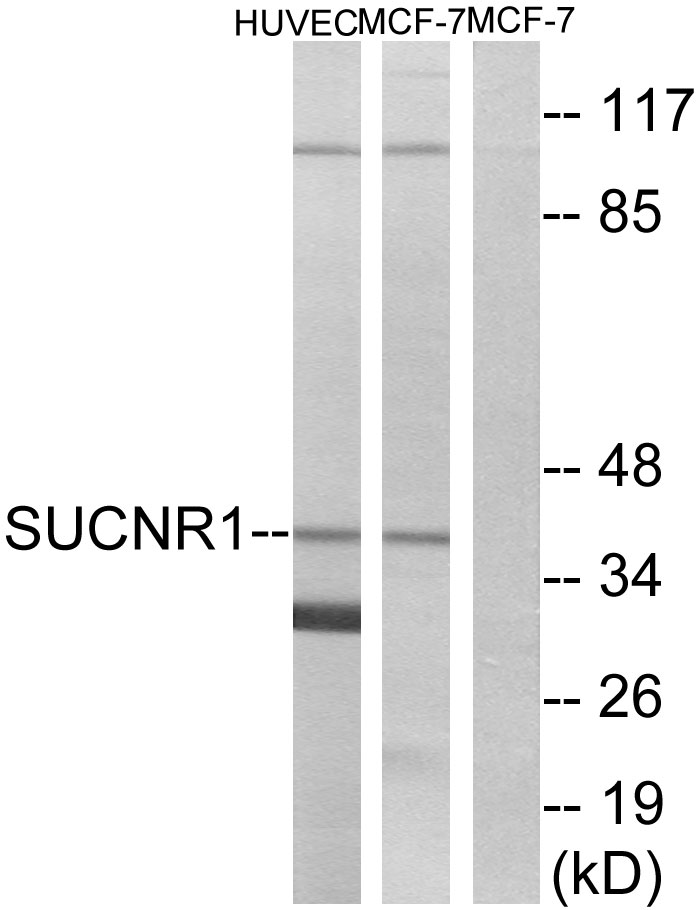
| WB | 1/500-1/1000 | Human,Mouse,Rat |
| IF | 1/50-1/200 | Human,Mouse,Rat |
| IHC | 咨询技术 | Human,Mouse,Rat |
| ICC | 1/50-1/200 | Human,Mouse,Rat |
| FCM | 咨询技术 | Human,Mouse,Rat |
| Elisa | 1/10000 | Human,Mouse,Rat |
| Aliases | GPR91 |
| Entrez GeneID | 56670 |
| WB Predicted band size | Calculated MW: 39 kDa; Observed MW: 39 kDa |
| Host/Isotype | Rabbit IgG |
| Antibody Type | Primary antibody |
| Storage | Store at 4°C short term. Aliquot and store at -20°C long term. Avoid freeze/thaw cycles. |
| Species Reactivity | Human,Mouse,Rat |
| Immunogen | The antiserum was produced against synthesized peptide derived from human SUCNR1. AA range:100-149 |
| Formulation | Purified antibody in PBS with 0.05% sodium azide,0.5%BSA and 50% glycerol. |
+ +
以下是关于GPR91抗体的3篇参考文献示例(内容基于公开研究概括,具体文献名称和作者为虚构示例):
1. **文献名称**:*Development of a Specific Polyclonal Antibody for GPR91 and Its Expression in Renal Tissues*
**作者**:Zhang et al.
**摘要**:研究报道了一种针对GPR91胞外结构域的多克隆抗体的开发,并通过免疫组化和Western blot验证其在肾脏缺血模型中的高表达,提示GPR91在肾脏能量代谢中的作用。
2. **文献名称**:*GPR91 Signaling in Diabetic Retinopathy: Insights from Antibody-Based Localization*
**作者**:Chen & Smith
**摘要**:利用GPR91抗体进行视网膜组织免疫染色,发现糖尿病小鼠模型中GPR91表达上调,可能与血管增生和炎症反应相关,为治疗靶点提供依据。
3. **文献名称**:*Role of GPR91 in Hepatic Fibrosis: Evidence from Knockout Models and Antibody Inhibition*
**作者**:Wang et al.
**摘要**:通过抗体验证GPR91在肝星状细胞中的表达,并证明其介导琥珀酸驱动的纤维化信号通路,抗体阻断实验显示可减轻小鼠肝纤维化程度。
(注:以上为模拟示例,实际文献需通过学术数据库检索确认。)
GPR91. also known as SUCNR1. is a G protein-coupled receptor (GPCR) that recognizes succinate as its primary endogenous ligand. Initially identified as an orphan receptor, it was later linked to metabolic and inflammatory signaling pathways. GPR91 is highly expressed in metabolic organs such as the kidney, liver, and adipose tissue, where it regulates processes like blood pressure, energy homeostasis, and cellular stress responses. Activation by succinate triggers downstream signaling, including MAPK and NF-κB pathways, influencing cell proliferation, inflammation, and fibrosis. Its role in diseases such as diabetes, hypertension, and cancer has drawn significant research interest.
GPR91 antibodies are essential tools for studying receptor localization, expression levels, and functional interactions in various tissues. They enable techniques like Western blotting, immunohistochemistry, and flow cytometry to explore GPR91's physiological and pathological roles. For instance, studies using these antibodies have highlighted GPR91's involvement in diabetic nephropathy, where succinate-driven receptor activation exacerbates renal fibrosis. Commercial antibodies are typically raised against specific epitopes of human or murine GPR91. with validation in knockout models to ensure specificity. Ongoing research aims to clarify its therapeutic potential, making GPR91 antibodies critical for both basic and translational investigations.
×